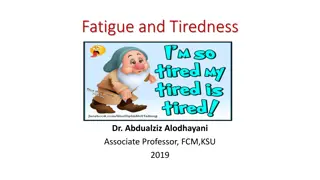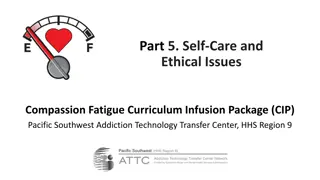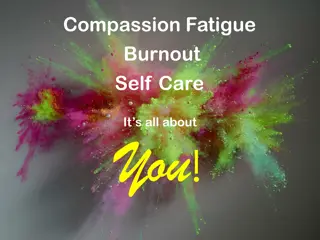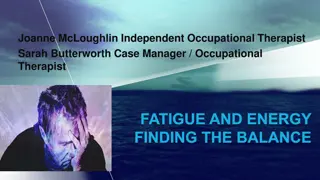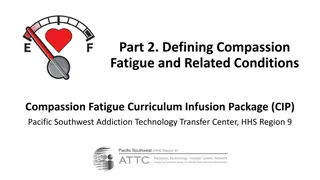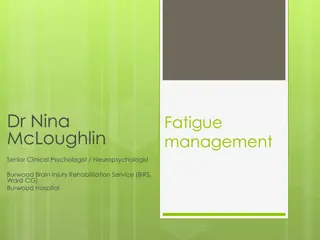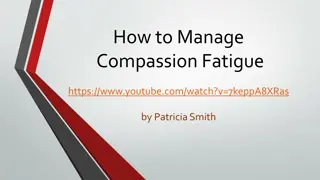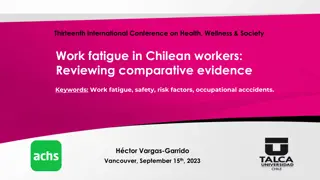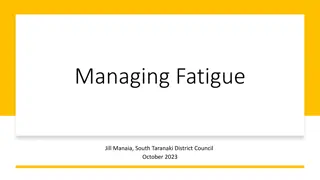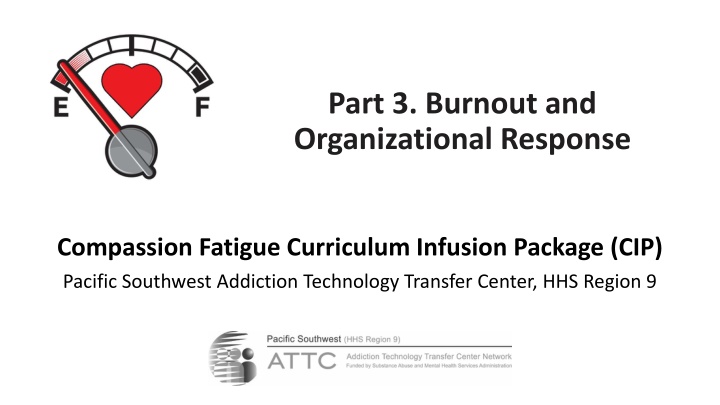
Professional Burnout and Organizational Responses in Human Services
Explore the concept of professional burnout, its impact on human service professionals, and organizational strategies to prevent burnout. Learn about the three domains of burnout and new insights on addressing and managing burnout in the workplace.
Download Presentation

Please find below an Image/Link to download the presentation.
The content on the website is provided AS IS for your information and personal use only. It may not be sold, licensed, or shared on other websites without obtaining consent from the author. If you encounter any issues during the download, it is possible that the publisher has removed the file from their server.
You are allowed to download the files provided on this website for personal or commercial use, subject to the condition that they are used lawfully. All files are the property of their respective owners.
The content on the website is provided AS IS for your information and personal use only. It may not be sold, licensed, or shared on other websites without obtaining consent from the author.
E N D
Presentation Transcript
Part 3. Burnout and Organizational Response Compassion Fatigue Curriculum Infusion Package (CIP) Pacific Southwest Addiction Technology Transfer Center, HHS Region 9
Burnout The concept of professional burnout actually introduced a new orientation to the influence of the stress associated with working with difficult clients to one that accounted for both the interpersonal relationship between the human service professional and the client and also the relationship between the professional and the social service agency. Maslach, 2001
Part 3 Outline Definition of burnout and examples New thoughts about burnout How organizations can help prevent burnout Organizations that treat individuals with Opioid Use Disorders (OUDs) and recommendations regarding burnout
Burnout has three distinct domains: emotional exhaustion depersonalization reduced sense of personal accomplishment Maslach, 1982, 2001; Maslach & Jackson, 1981; Maslach & Leiter, 1997
Emotional exhaustion: a practitioner s emotional resources become depleted by the chronic needs, demands, and expectations of clients, supervisors, and organizations Depersonalization (also referred to as cynicism): the negative, cynical, or excessively detached responses to coworkers or clients and their situations. This domain is a representation of the change in interpersonal thoughts and feelings regarding practice with clients that may occur in the process of professional burnout. Reduction in one s sense of personal accomplishment: professional helpers feel inadequate when clients do not respond to intervention, despite efforts to help them. This domain of the burnout phenomenon may also occur in response to bureaucratic constraints and administrative demands that often accompany social service practice, such as dictating client records or completing required administrative documentation. DOMAINS Maslach, 1998; 2001
Some New Thoughts on Burnout Some people will thrive, no matter what. Modern life not just working in healthcare is stressful. Symptoms differ among individuals, including within the three domains: emotional exhaustion, de-personalization, and loss of self-worth. Burnout may manifest as cynicism, anger, meanness, withdrawal, silence, or may go undetected by individuals and those around them. What is commonly understood as burnout can affect new practitioners not just those with years of exposure especially if those professionals have an imbalance between expectations and reality. Burnout is not a binary or dichotomous condition. In other words, burnout is not merely present or absent, but describes a lower emotional state on a continuum that incorporates the three aforementioned subdomains. Brindley et al., 2019
Factors contributing to professional burnout may occur at the individual, organizational, or client levels (or in combination).
Organizations Can be Helpful Important that staff members feel the organization values their opinion shows concern for their well-being cares for their satisfaction at work Agencies should acknowledge and normalize the challenges of working with traumatized populations helps to alleviate stigma and discomfort for staff experiencing symptoms Other activities agencies can do: Make discussion of self-care a regular and accepted topic model self-care by supervisors and leaders offering regular trainings that describe the warning signs and symptoms associated with STS and possible coping strategies may help both with prevention and early intervention Newell & MacNeil, 2010; Rienks, 2020
Behavioral Health Organizations, Hotlines, and Healthcare Providers Should: Educate Personnel about Compassion Fatigue Help Personnel Understand that Distress is a Normal Part of Experiencing Another s Crises Assist Staff in Managing Their Emotions Recognize the Importance of Cultural Competence and Respect Address Organizational Health Make Regulations and Expectations Explicit
A study specific to substance abuse counselors found that organizational support does provide some protection from negative consequences of job frustration. human service organizations should encourage their supervisors and the organization to be supportive of the workers under their care by providing opportunities for: Continuing education Clinical supervision Debriefings Team building Important to create an organizational climate where the worker can feel comfortable approaching their supervisor and/or co- workers with any concerns or requests for assistance Perkins & Oser, 2014
A recent study of counselors working at an Opioid Treatment Program (OTP) suggested these activities could decrease work place stress. More staff-wide encounters Improved communication Accessible paid time off More clinical supervision
Proposed solutions for combatting stigmatization among providers on the front lines of the opioid crisis Knaack et al., 2019
This ends Part 3 of the five-part Compassion Fatigue and the Behavioral Health Workforce Curriculum Infusion Package (CIP) Other parts of this CIP can be found in the Products & Resources Catalog on the Pacific Southwest ATTC website: http://www.psattc.org


